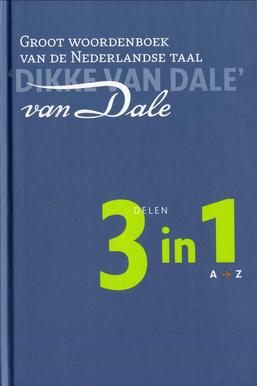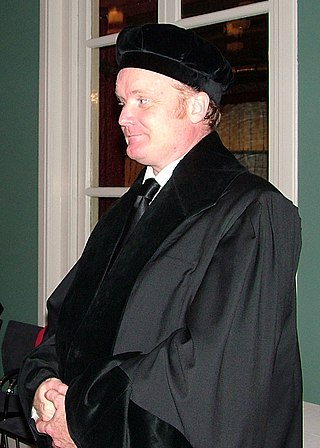
The Dutch Language Union is an international regulatory institution that governs issues regarding the Dutch language. It is best known for its spelling reforms which are promulgated by member states, grammar books, the Green Booklet and its support of Dutch language courses and studies worldwide. It was founded on a treaty concluded between the Netherlands and Belgium on 9 September 1980. Suriname has been an associate member of the Taalunie since 2004.

IJ is a digraph of the letters i and j. Occurring in the Dutch language, it is sometimes considered a ligature, or a letter in itself. In most fonts that have a separate character for ij, the two composing parts are not connected but are separate glyphs, which are sometimes slightly kerned.
Dutch orthography uses the Latin alphabet. The spelling system is issued by government decree and is compulsory for all government documentation and educational establishments.

A pannenkoek ) or Dutch pancake is a style of pancake with origins in the Netherlands. Pannenkoeken are usually larger and much thinner than their American or Scotch pancake counterparts, but not as thin as crêpes. They may incorporate slices of bacon, apples, cheese, or raisins. Plain ones are often eaten with treacle, appelstroop or (powdered) sugar and are sometimes rolled up to be eaten by hand or with cutlery.
A tussenvoegsel in a Dutch name is a family name affix positioned between a person's given name and the main part of their family name. There are similar concepts in many languages, such as Celtic family name prefixes, French particles, and the German von.

The Word list of the Dutch language is a spelling dictionary of the Dutch language. It is officially established by the Dutch Language Union. Because of the colour of its published form, it is better known as the Green Booklet.
Witte Boekje is the popular name for the Spelling Guide of Our Language, a publication of the Genootschap Onze Taal. The first edition was released in October 1998; the latest edition is the tenth and was released in 2004. All these publications are explanations of the official spelling rules, as set by the Dutch Language Union.
The Dutch have a code of etiquette which governs social behaviour and is considered important. Because of the international position of the Netherlands, many books have been written on the subject. Some customs may not be true in all regions and they are never absolute. In addition to those specific to the Dutch, many general points of European etiquette apply to the Dutch as well, as the Dutch generally view themselves as "taking the lead" in Europe but also part of it and the wider world as a whole.
The history of Dutch orthography covers the changes in spelling of Dutch both in the Netherlands itself and in the Dutch-speaking region of Flanders in Belgium. Up until the 18th century there was no standardization of grammar or spelling. The Latin alphabet had been used from the beginning and it was not easy to make a distinction between long and short vowels (a / aa). The word jaar (year) for instance, could be spelt jar,jaer,jair, or even yaer and iaer. With the spirit of the French Revolution, attempts were made to unify Dutch spelling and grammar. Matthijs Siegenbeek, professor at Leiden was officially asked in 1801 to draw up a uniform spelling.
A genootschap is a specifically Dutch form of company, association, society or cooperative, named after the pursuit for which its members gather.
Spocanian is a constructed language, created by the Dutch linguist Rolandt Tweehuysen. Unlike such invented languages as Esperanto, Spocanian was never intended to be used for international communication; instead, it serves as the language of Spocania, a fictional island group in the Atlantic Ocean, southwest of Ireland.

Jérôme Louis Heldring was a Dutch journalist. He was columnist (1953–2012) and editor-in-chief (1968–1972) of the newspapers Nieuwe Rotterdamsche Courant and NRC Handelsblad.
Robine Tanya van der Meer is a Dutch actress and model. She is best known as Meike Griffioen in Goede tijden, slechte tijden and for hosting the TV-show Model in 1 dag.
The subjunctive in Dutch is a verb mood typically used in dependent clauses to express a wish, command, emotion, possibility, uncertainty, doubt, judgment, opinion, necessity, or action that has not yet occurred.
Rolf Hendrik Bremmer is a Dutch academic. He is professor of Old and Middle English, and extraordinary professor of Old Frisian, at Leiden University.

Van Dale's Great Dictionary of the Dutch Language, called Dikke Van Dale for short, is the leading dictionary of the Dutch language. The latest edition was published in April 2022.
Dutch profanity can be divided into several categories. Often, the words used in profanity by speakers of Dutch are based around various names for diseases. In many cases, these words have evolved into slang, and many euphemisms for diseases are in common use.
Swaffelen is a Dutch term meaning to hit one's soft or semi-hard penis - often repeatedly - against an object or another person's body. Swaffelen was named as the word of the year in the Netherlands and Belgium in 2008.

Marc van Oostendorp is a Dutch linguist and Esperantist. From 2004 he has served as a weekly commentator on linguistics for Radio Noord-Holland. Since 2007, he has researched phonological microvariation, dialectology and interlinguistics. He is currently attached to the Radboud University in Nijmegen.

Cruijffiaans is the name given to the way of speaking, or a collection of sayings, made famous by Dutch association football player and coach Johan Cruijff (1947–2016), particularly "one-liners that hover somewhere between the brilliant and the banal". An example is "Je moet altijd zorgen dat je één doelpunt meer scoort als de tegenstander"








